
The sweet potato or sweetpotato is a dicotyledonous plant that belongs to the bindweed or morning glory family, Convolvulaceae. Its large, starchy, sweet-tasting tuberous roots are used as a root vegetable. The young shoots and leaves are sometimes eaten as greens. Cultivars of the sweet potato have been bred to bear tubers with flesh and skin of various colors. Sweet potato is only distantly related to the common potato, both being in the order Solanales. Although darker sweet potatoes are often referred to as "yams" in parts of North America, the species is not a true yam, which are monocots in the order Dioscoreales.

Peking duck is a dish from Beijing (Peking) that has been prepared since the Imperial era. The meat is characterized by its thin, crispy skin, with authentic versions of the dish serving mostly the skin and little meat, sliced in front of the diners by the cook. Ducks bred especially for the dish are slaughtered after 65 days and seasoned before being roasted in a closed or hung oven. The meat is often eaten with spring onion, cucumber and sweet bean sauce with pancakes rolled around the fillings. Sometimes pickled radish is also inside. Crispy aromatic duck is a similar dish to Peking duck and is popular in the United Kingdom.

A mooncake is a Chinese bakery product traditionally eaten during the Mid-Autumn Festival (中秋節). The festival is primarily about the harvest while a legend connects it to moon watching, and mooncakes are regarded as a delicacy. Mooncakes are offered between friends or on family gatherings while celebrating the festival. The Mid-Autumn Festival is widely regarded as one of the four most important Chinese festivals.
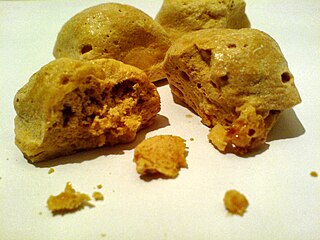
Honeycomb toffee, honeycomb candy, sponge toffee, cinder toffee, seafoam, or hokey pokey is a sugary toffee with a light, rigid, sponge-like texture. Its main ingredients are typically brown sugar and baking soda, sometimes with an acid such as vinegar. The baking soda and acid react to form carbon dioxide which is trapped in the highly viscous mixture. When acid is not used, thermal decomposition of the baking soda releases carbon dioxide. The sponge-like structure is formed while the sugar is liquid, then the toffee sets hard. The candy goes by a variety of names and regional variants.

Corn on the cob is a culinary term for a cooked ear of sweet corn (maize) eaten directly off the cob. The ear is picked while the endosperm is in the "milk stage" so that the kernels are still tender. Ears of corn are steamed, boiled, or grilled usually without their green husks, or roasted with them. The husk leaves are removed before serving.

Cellophane noodles, or fensi, sometimes called glass noodles, are a type of transparent noodle made from starch and water. A stabilizer such as chitosan may also be used.

The cuisine of Philadelphia was shaped largely by the city's mixture of ethnicities, available foodstuffs and history. Certain foods have become associated with the city.
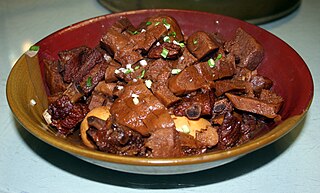
Shandong cuisine, more commonly known in Chinese as Lu cuisine, is one of the Eight Culinary Traditions of Chinese cuisine and one of the Four Great Traditions. It is derived from the native cooking style of Shandong Province, a northern coastal province of China.
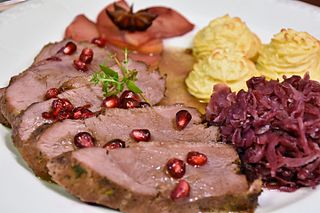
Roast goose is cooking goose meat using dry heat with hot air enveloping it evenly on all sides. Many varieties of roast goose appear in cuisines around the world, including Cantonese, European, and Middle Eastern cuisines. Roasting can enhance its flavor.
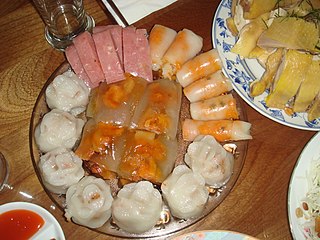
In Vietnamese, the term bánh translates loosely as "cake" or "bread", but refers to a wide variety of prepared foods that can easily be eaten by hands or chopsticks. With the addition of qualifying adjectives, bánh refers to a wide variety of sweet or savory, distinct cakes, buns, pastries, sandwiches, and other food items, which may be cooked by steaming, baking, frying, deep-frying, or boiling. Foods made from wheat flour or rice flour are generally called bánh, but the term may also refer to certain varieties of noodle and fish cake dishes, such as bánh canh and bánh hỏi.
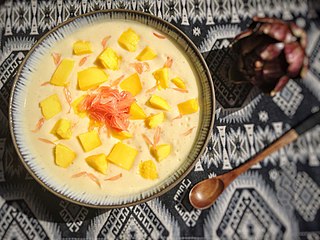
Chè is any traditional Vietnamese sweet beverage, dessert soup or stew, or pudding. Chè includes a wide variety of distinct soups or puddings. Varieties of Chè can be made with mung beans, black-eyed peas, kidney beans, tapioca, jelly, fruit, and coconut cream. Other types are made with ingredients such as salt, aloe vera, seaweed, lotus seed, sesame seed, sugar palm seeds, taro, cassava and pandan leaf extract. Some varieties, such as chè trôi nước, may also include dumplings. Chè are often prepared with one of a number of varieties of beans, tubers, and/or glutinous rice, cooked in water and sweetened with sugar. In southern Vietnam, chè are often garnished with coconut creme.

Castañada, Magosta, Magosto or Magusto, is a traditional festival on the Iberian Peninsula. It is popular in Portugal, Galicia and some areas of northern Spain, such as Cantabria, Asturias, Catalonia, and the provinces of León, Zamora and Salamanca and Cáceres, but also in some parts of the Canary Islands. The festival is also celebrated in both sides of the French-Spanish border. It has also spread internationally as a 'chestnut party'. Etymological origins are unknown, but there are several theories for the Magosto name: Magnus Ustus or Magum Ustum.

Regional street food is street food that has commonalities within a region or culture.

Fried sweet potato features in a variety of dishes and cuisines including the popular sweet potato fries, a variation of French fries using sweet potato instead of potato. Fried sweet potatoes are known as patates in Guinean cuisine, where they are more popular than potatoes and more commonly used to make fries.

Street food in South Korea has traditionally been seen as a part of popular culture in Korea. Historically, street food mainly included foods such as eomuk, bungeo-ppang and tteok-bokki. Street food has been sold through many types of retail outlets, with new ones being developed over time. Recently, street food has seen a popular resurgence in South Korea, such as at the Night Market at Hangang Park, which is called "Bamdokkaebi Night Market"(밤도깨비야시장).

Roasted chestnut is a popular autumn and winter street food in East Asia, Europe, and New York City. Asian chestnuts as well as European chestnuts can be used.

Hoshiimo (干し芋) is a sweet potato snack popular in Japan similar to a number of other dried foods in Asia. This food generally consists of steamed, dried, sweet potatoes that are skinned and sliced with no artificial sweeteners added. In some cases, the sweet potatoes may be roasted rather than steamed. The surface may be covered with a white powder. Not to be mistaken for mold, this is a form of crystallized sugar that emerges as the sweet potatoes dry. With a chewy texture and sweet potato flavor, this food can be eaten raw or roasted. This dish is particularly rich in vitamins A, B1, C, and E and contains much potassium and calcium as well as dietary fiber. As an alkaline food, reputedly it helps the body maintain a healthy pH balance.



























